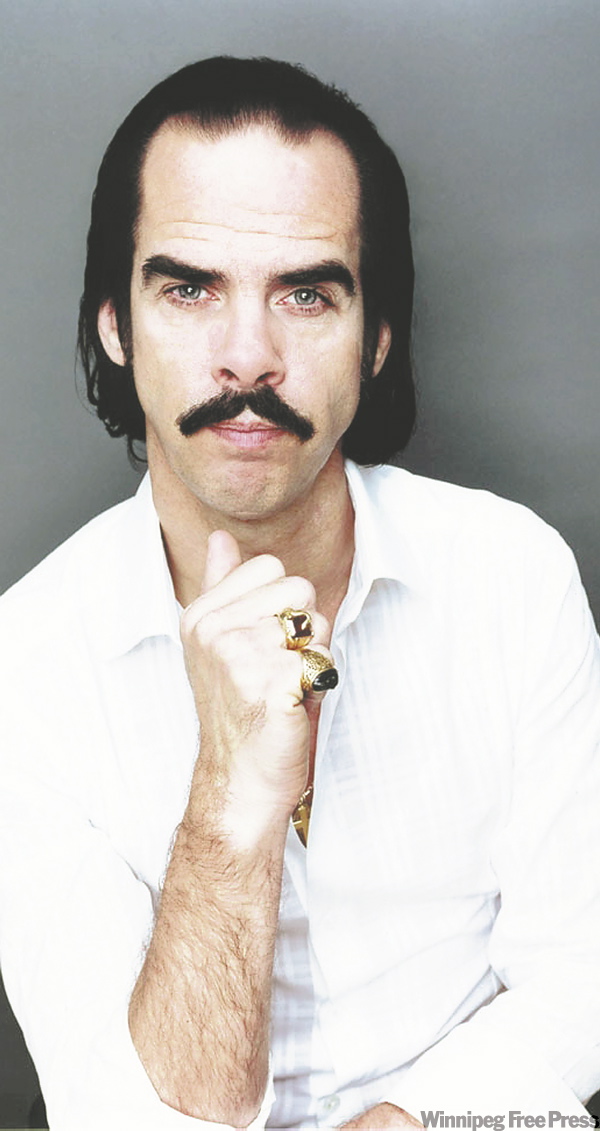Protagonist of Nick Cave’s latest book a very bad seed
Advertisement
Read this article for free:
or
Already have an account? Log in here »
To continue reading, please subscribe:
Monthly Digital Subscription
$1 per week for 24 weeks*
- Enjoy unlimited reading on winnipegfreepress.com
- Read the E-Edition, our digital replica newspaper
- Access News Break, our award-winning app
- Play interactive puzzles
*Billed as $4.00 plus GST every four weeks. After 24 weeks, price increases to the regular rate of $19.00 plus GST every four weeks. Offer available to new and qualified returning subscribers only. Cancel any time.
Monthly Digital Subscription
$4.75/week*
- Enjoy unlimited reading on winnipegfreepress.com
- Read the E-Edition, our digital replica newspaper
- Access News Break, our award-winning app
- Play interactive puzzles
*Billed as $19 plus GST every four weeks. Cancel any time.
To continue reading, please subscribe:
Add Winnipeg Free Press access to your Brandon Sun subscription for only
$1 for the first 4 weeks*
*$1 will be added to your next bill. After your 4 weeks access is complete your rate will increase by $0.00 a X percent off the regular rate.
Read unlimited articles for free today:
or
Already have an account? Log in here »
Hey there, time traveller!
This article was published 24/09/2009 (5832 days ago), so information in it may no longer be current.
NICK Cave’s fans aren’t quick to blush. They’ve been acclimatized by three decades of ferocious visions from the revered singer-songwriter’s haunted head, primarily through the often beautiful, often brutal catharsis of the Bad Seeds.
But even Cave’s most hardened acolytes may be startled by some of the protagonist’s exploits in The Death of Bunny Munro (HarperCollins, $29.99).
The hallucinatory tale of a sexaholic beauty-product salesman’s downward spiral, Cave’s second novel (and his first in 20 years) is a gleefully profane read. Still, Cave has always woven together language from the gutter and the heavens, and isn’t about to stop.

"I don’t want to read anything that doesn’t have a heart and some substance to it," Cave told Canwest News Service on Friday, at the end of a week of North American promotion that included a Toronto bookstore appearance and an evening at Ottawa’s Writers Festival.
"If you look at someone like Humbert Humbert in Lolita, if you take away the literary style and the way (Nabokov) has about describing Lolita and all that sort of stuff, it’s an incredibly sordid, nasty little story. But the way he writes, it’s a thing of profound beauty. And you have huge feelings towards this pedophile, ultimately."
Bunny Munro (who, like Cave, lives in Brighton, England) is an abhorrent man — driving his wife to suicide, and more concerned about scoring with his clients than about the needs of his adoring nine-year-old son. But he is a man, not a cartoon.
"I wanted him to be extreme, I wanted him to be monstrous, but recognizable," Cave said. "Also, that we recognized ourselves in the character in some respect. That’s where you sympathize, I think."
Cave joked that any man who claimed not to recognize part of himself in Munro "has his wife sitting next to him." Those who deny any familiarity with Munro’s raging libido will at least recognize the novel’s pop-culture references — uncommon territory for Cave, who is more likely to take inspiration from the New Testament than the new mega-mall.
"This guy has to go to places that are uncomfortable. There’s also a certain amount of enjoyment for me to take the story to places that may have been uncomfortable for the reader, in the sense that this is not the kind of stuff that Nick Cave normally writes about. There was certainly an enjoyment in writing a contemporary story and being able to fill it with very contemporary things like Topshop and Avril Lavigne, McDonald’s and KFC, all this sort of stuff that just doesn’t appear in my songs."
Munro’s lust for Lavigne is a recurring theme in the mordantly funny novel. At the Writers Festival, Cave apologized to the pop star’s father if he happened to be in the audience; sitting in his hotel the next morning, a few hours away from Lavigne’s old Napanee stomping grounds, Cave said: "I know the Canadian publishers were secretly hoping that I would be shot here in Ottawa and it would be wonderful for book sales."
It didn’t take long for Cave to settle on Lavigne as Munro’s ultimate fantasy. "We were doing a tour and Avril Lavigne was touring maybe one week ahead of us, so there were posters everywhere of her. But I’ve always thought she was kind of grand. She felt like a good person to write about; there is something very innocent about her that made Bunny’s interest in her all the more predatory. I couldn’t have done that about, say, Madonna."
The Death of Bunny Munro had its genesis as a screenplay by Cave that was left languishing. The novel was written on tour, in a far more compressed time span than the period that birthed its predecessor, 1989’s southern-gothic tragedy And the Ass Saw the Angel (the writing of which "was fun, but it stopped being fun after a couple of years"). Road life allows prime opportunities for observation, Cave acknowledges, which he brought to bear on his protagonist’s "keen eye for detail and for the vulnerability in people; he knows people quite well on a surface level."
Nick Cave’s The Death of Bunny Munro is out now. It is also available as an audiobook read by Cave.
— Canwest News Service

